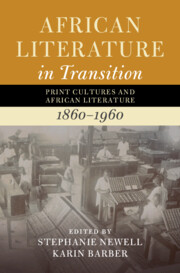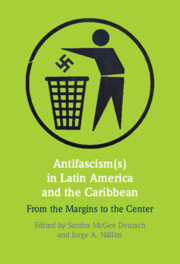Refine search
Actions for selected content:
393 results
Stabilising contested normative orders: how international city networks contribute to preventing norm decay
-
- Journal:
- Global Constitutionalism , First View
- Published online by Cambridge University Press:
- 17 November 2025, pp. 1-24
-
- Article
-
- You have access
- Open access
- HTML
- Export citation
Introduction
-
-
- Book:
- African Literature in Transition
- Published online:
- 23 October 2025
- Print publication:
- 06 November 2025, pp 1-12
-
- Chapter
-
- You have access
- HTML
- Export citation
7 - Gilded Age Heroes
-
- Book:
- Self-Made
- Published online:
- 30 October 2025
- Print publication:
- 30 October 2025, pp 153-180
-
- Chapter
- Export citation

African Literature in Transition
- Print Cultures and African Literature, 1860–1960
-
- Published online:
- 23 October 2025
- Print publication:
- 06 November 2025
2 - Class Matters: The Sociology of the Profession
-
- Book:
- Palestinian Doctors
- Published online:
- 12 September 2025
- Print publication:
- 02 October 2025, pp 36-70
-
- Chapter
- Export citation
Prosecutorial-NGO Complex: new legal opportunity structures and the role of (I)NGOs in universal jurisdiction trials on Syria
-
- Journal:
- Law & Society Review ,
- Published online by Cambridge University Press:
- 30 September 2025, pp. 1-33
-
- Article
-
- You have access
- Open access
- HTML
- Export citation
1 - The Network Machine Learning Landscape
- from Part I - Foundations
-
- Book:
- Hands-On Network Machine Learning with Python
- Published online:
- 23 September 2025
- Print publication:
- 18 September 2025, pp 3-18
-
- Chapter
- Export citation
3 - From Pattern to Constructions
-
- Book:
- Pattern, Construction, System
- Published online:
- 21 August 2025
- Print publication:
- 04 September 2025, pp 25-56
-
- Chapter
-
- You have access
- Open access
- HTML
- Export citation
Decomposing Network Influence: Social Influence Regression
-
- Journal:
- Political Analysis , First View
- Published online by Cambridge University Press:
- 27 August 2025, pp. 1-20
-
- Article
-
- You have access
- Open access
- HTML
- Export citation
Introduction
-
-
- Book:
- María Irene Fornés In Context
- Published online:
- 27 August 2025
- Print publication:
- 07 August 2025, pp xxix-xxxviii
-
- Chapter
-
- You have access
- HTML
- Export citation
Chapter 7 - Local Contexts and Transnational Influences
-
-
- Book:
- Antifascism(s) in Latin America and the Caribbean
- Published online:
- 21 July 2025
- Print publication:
- 07 August 2025, pp 143-163
-
- Chapter
- Export citation
2 - Religious Networks in the Reformation Era
-
- Book:
- Christianity at the Crossroads
- Published online:
- 19 May 2025
- Print publication:
- 31 July 2025, pp 45-75
-
- Chapter
- Export citation
1 - Towards a Theory of Transnational Religious Change
-
- Book:
- Christianity at the Crossroads
- Published online:
- 19 May 2025
- Print publication:
- 31 July 2025, pp 13-44
-
- Chapter
- Export citation
5 - Women’s Networks
-
- Book:
- Christianity at the Crossroads
- Published online:
- 19 May 2025
- Print publication:
- 31 July 2025, pp 146-178
-
- Chapter
- Export citation
6 - “Only Connect!”
-
- Book:
- Christianity at the Crossroads
- Published online:
- 19 May 2025
- Print publication:
- 31 July 2025, pp 179-208
-
- Chapter
- Export citation
3 - Religious Networks in the Age of Empire in New Spain and Africa
-
- Book:
- Christianity at the Crossroads
- Published online:
- 19 May 2025
- Print publication:
- 31 July 2025, pp 76-107
-
- Chapter
- Export citation
Introduction
-
- Book:
- Christianity at the Crossroads
- Published online:
- 19 May 2025
- Print publication:
- 31 July 2025, pp 1-12
-
- Chapter
- Export citation
Conclusion
-
- Book:
- Christianity at the Crossroads
- Published online:
- 19 May 2025
- Print publication:
- 31 July 2025, pp 209-220
-
- Chapter
- Export citation

Antifascism(s) in Latin America and the Caribbean
- From the Margins to the Center
-
- Published online:
- 21 July 2025
- Print publication:
- 07 August 2025
27 - Help and Rescue in Eastern Europe: The Case of Poland
-
-
- Book:
- The Cambridge History of the Holocaust
- Published online:
- 16 May 2025
- Print publication:
- 12 June 2025, pp 448-462
-
- Chapter
- Export citation

